Antarctic Field Science and a Flight to Halley VI
It’s about time to touch base! It's been seven months and I would like to start with an apology for my total lack of news.
I’ll start with my return to Rothera way back in January. The station was bustling with 170 people, the busiest I’ve ever seen it. It felt quite like an airport with multiple planes taking off when weather allowed to support science projects in the deep field. Projects are varied and come in many forms, below is a map of field sites which are supported with input and logistics from Rothera.
Map produced by the Mapping and Geographic Information Centre, British Antarctic Survey. © UKRI
To name a few projects:
Eight Automatic Weather Stations, distributed across the peninsula and in the Halley region (Weddell Sea), are serviced annually. These weather stations contribute to climate science and forecasting. Servicing the stations involve downloading data, raising the instruments and power supply above the snow accumulation and conducting repairs and updates (There will be an episode uploaded to the Iceworld podcast interviewing the station's Meteorologist- Jo Cole which will describe the field work she conducts in more detail).
GPS measurements and antennas are installed at specific sites with the aim to improve our prediction of future sea-level rise. The instruments measure GPS points on antarctic bedrock to account for a phenomenon called Glacial Isostatic Adjustment- the ongoing solid Earth deformation which takes place in response to past ice-sheet mass change. This data contribute towards validating models which are crucial in interpreting satellite data and taking into account the movement of the Earth in response to past glaciation.
A collaboration between BAS scientists and the US programme have permitted observations of the Thwaites Glacier (West Antarctica, square 'India' on the map above). Their field work involves the recovery of GPS instruments, ground based radars and seismometers to investigate the hydrology and how conditions at the bed of the glacier influence its behavior. This project will also improve predictions about future sea-level contribution from one of the most unstable glaciers in Antarctica.
On 4th December 2021, a solar eclipse was captured across the Ronne Ice Shelf and Ellsworth Land (South East of the West Antarctic Peninsula, orange circle on the map) with the aim to better understand the interaction between the sun and space weather (check out Jaskiran Nagi's vlog- the electronics engineer who installed a Low Power Magnetometer instrument to capture the data this summer). Other Low Power Magnetometers were measuring the variation in the Earth's magnetic field as part of an international observing campaign.
Most people on station are able to assist with the transportation of people and equipment to facilitate science projects by acting as a 'co-pilot' in Twin Otter aircrafts with the opportunity to take the controls (under the pilot’s supervision) whilst they write notes and take weather reports. It’s quite the experience. I was amazed that we could be given the control system and under the pilot’s supervision, I was flying over Antarctica!
A BAS pilot, Ian Potten, landing and taking off from Fossil Bluff
As I arrived late in the season (January), most of the science projects were drawing to a close. They made the most of optimal weather and abundant daylight. In addition to science support, Rothera’s Air Unit facilitates the transfer of personnel between other British Antarctic Stations. Once such station, Halley VI. was in its close-down phase where the last four people were winterising the station. Once this job was complete, a Twin Otter was sent from Rothera to uplift them.
I was given the chance to fly with Ian Potten, a British Antarctic Pilot with enormous experience and knowledge about the local area, to help with the final stages of Halley's dormancy for the 2022 winter. We left early one Friday morning in February making a stop at two fuel depots, Fossil Bluff (71°S) and Sky Blu (74°S), staged to operate as the air operations refueling facilities. We filled up the plane with jet fuel with the help of BAS Staff who were running Fossil Bluff and Sky Blu. We continued an eight hour flight over the Weddell sea where I saw icebergs the size of small countries stretching for kilometers and kilometers. I was astounded. We reached the Brunt Ice Shelf and descended towards HalleyVI.
Landing and refueling the aircraft at Fossil Bluff
Landing on the blue ice (1.2 km) runway at Sky Blu
The sun was low in the sky and beautiful streaks of orange and saffron light patterned the sky. As we descended to 2000 feet, small colourful squares came into view in neat lines. We touched down at Halley VI, 11 hours later.

Halley VI is located at 75° degrees south. I stepped off the plane and I felt a new dry cold that immediately froze my nose hairs and seeped into my bones, this was a cold that I had not yet experienced. The cold instantly bit my cheeks and I grabbed my down jacket. I helped set up a ramp which was used to roll fuel drums down from the plane and whilst the plane was being refuelled, I helped Ian secure the plane by digging ‘dead men’ (structures to anchor the aircraft into the snow) and fixed protective covers into the propellers.
Barney, the station
leader, welcomed us and as I trotted off towards Halley station, I couldn’t
help feel as if I was in space looking around white desolate planes as far as
the eye could see. I was faced with eight large module buildings on stilts that certainly look extraterrestrial.
Halley VI's modules- the modules have the capacity to be raised using hydraulic legs in response to snow accumulation or in response to ice chasm's (Link to another of Jas Nagi's blog showing Chasm 1 which poses a threat to the position of Halley's station).
Halley is the oldest British Antarctic Survey’s base. In 2017 geologists were alerted to the potentially devastating interaction of two ice cracks, 'Chasm 1' and 'Halloween Crack', in response to the location of Hally IV on the Brunt Ice shelf. That year, it was deemed no longer safe for staff to overwinter and the station would only operate in the antarctic summer, hence our task to uplift the final summer staff. Now, each summer, preparations must be extensive to leave the station in a winterised state and great moves have been made towards automating scientific instrumentation using a micro-turbine power supply with a datalink to permit data collection throughout the Antarctic winter.
The station must be properly winterised in order to endure harsh antarctic winters with no personnel. All science instrumentation, vehicles, containers and buildings are raised on snow berms to account for the inevitable winter snow accumulation. It takes weeks of work and precision from the mechanical maintenance team to build extraordinarily level and symmetrical berms.
A Nodwell (a tracked crane) positioned on a berm
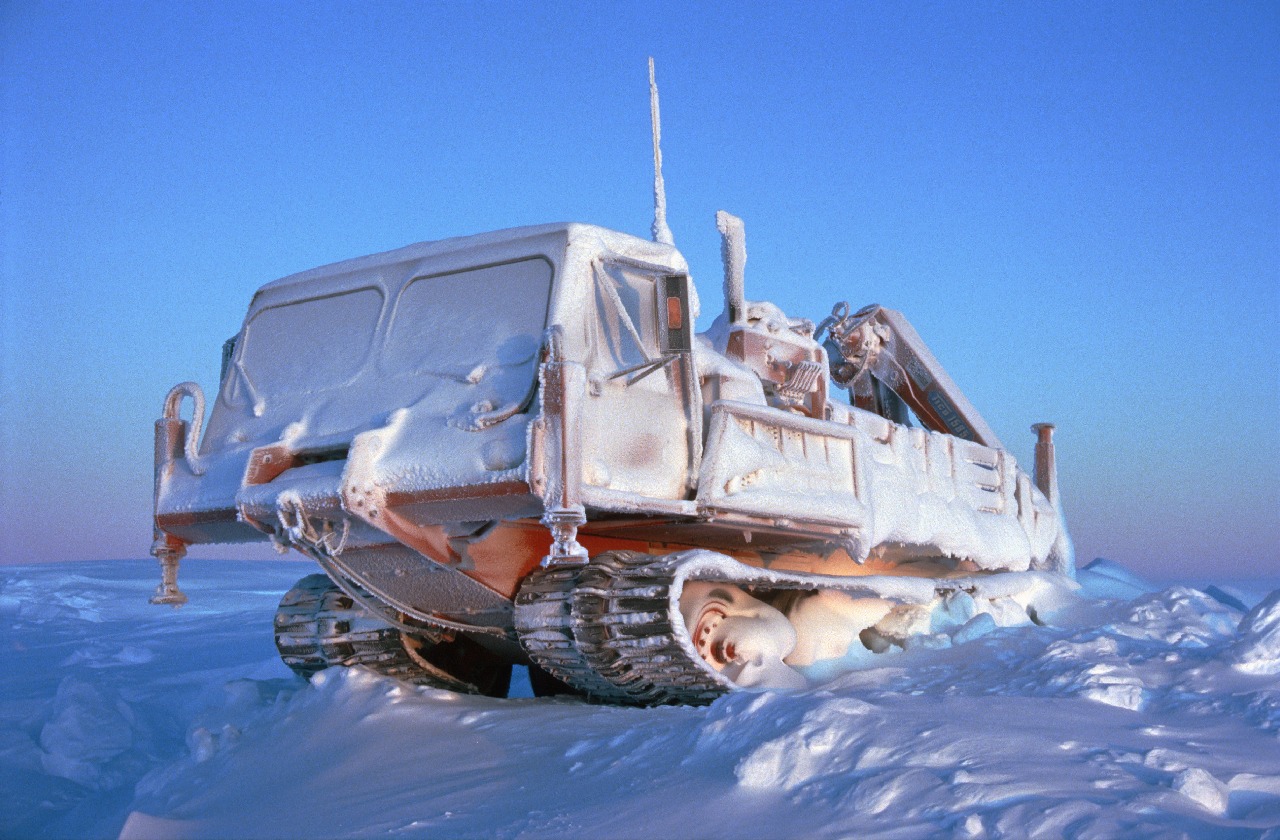
Photo credit- British Antarctic Survey
Halley VI is located in a climate sensitive zone and its main purpose is to monitor space weather and atmospheric processes.
Similar to Rothera, Meteorological balloons are lunched daily from the 'balloon container'. They carry a radiosonde which relays climate information such as temperature, humidity, pressure, wind speed and direction from the Earth's surface right into the stratosphere (which is about 25 km of altitude). Data from Meterological balloons are combined from Antarctic research stations to feed into live weather forecasts and climate research. This form of long-term research permits the detection of important patterns of decadal warming in the upper atmosphere.
Barney, the station leader and previous Halley Meteorologist, took me into the Meteorological office with an incredible 360 panoramic view of Halley VI. Ozone measurements begun at Halley in 1957 and resulted in the discovery of the hole in the ozone layer in 1985. I had a look under a cover at the Dobson spectrophotometer which was the piece of instrumentation that detected ozone depletion.
CFCs (Chlorofluorocarbons containing atoms of carbon, chlorine, florine) were linked to the destruction of the ozone. These used to be found in various items such as air-conditioning, refrigeration, insulation, aerosol cans and solvents. Following their ban, it is crucial that the recovery of the ozone is monitored.
Halley VI meteorological office with the Dobson spectrophotometer under cloth
At 5 am on Monday morning, Halley VI was left alone for the winter. We just closed the door without even a key to lock the station. I felt the apprehension amongst the close down staff that everything had been left in the correct state as they racked their brains and checked a list to ensure that everything was correctly stowed. Three Skua’s must have sensed that we were leaving and seemed to be waiting tentatively for our departure. Sightings of birds to far south are few and far between.
Three skuas, most likely a parent pair and a chickLanding at Sky-Hi Nunatak due to deteriorating visibility
Field guides and mechanics living in a melon hut at Sky Blue
We set up mountain tents and hunkered down for the night in -20°C, the coldest temperatures I've camped in. We heated emergency food packets (from the airplane supplies) in the snow hole that was dug below the entrance of the tent. I slept fully clothed, in a down sleeping bag and with a hat over my face; partly for the cold and partly to block out the 24 hours of daylight.
Setting up mountain tents ready to spend the night at Sky-Hi depot
View looking towards Sky Blu from Sky-Hi
The weather between Sky Blu and Rothera (a three-four hour flight) was deteriorating throughout the day and the hourly weather observations from both Sky Blu and Fossil bluff were showing signs of low cloud and a reduction in visibility, unsuitable for flying. We waited for eight sets of hourly weather observations before the weather lifted and we could continue the journey back to Rothera. Whilst we waited, I went for an ice skate on the blue ice runway. A completely surreal experience.



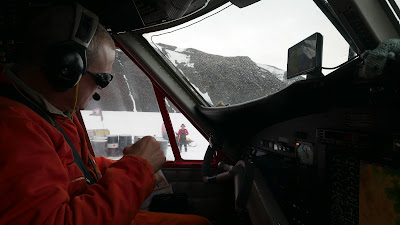






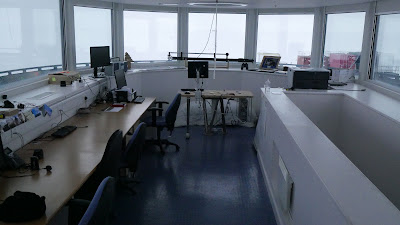














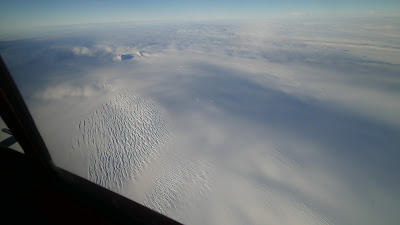
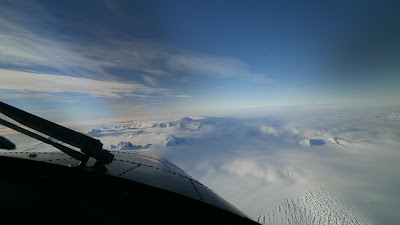




Comments
Post a Comment